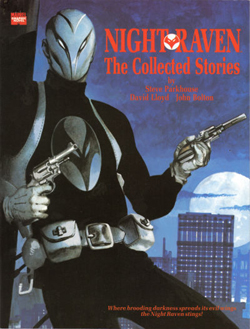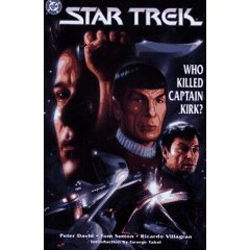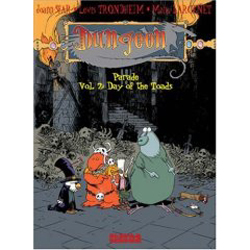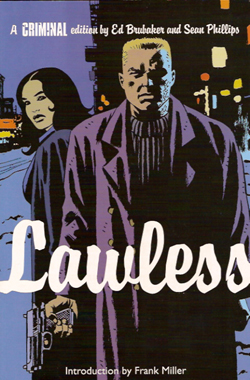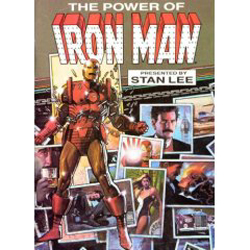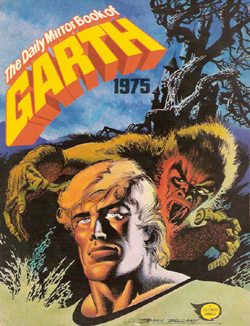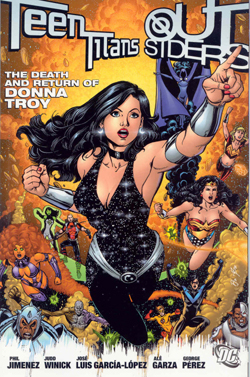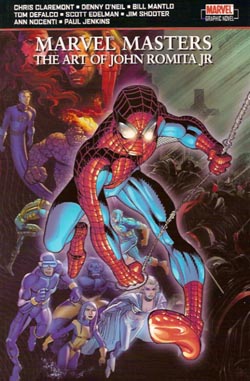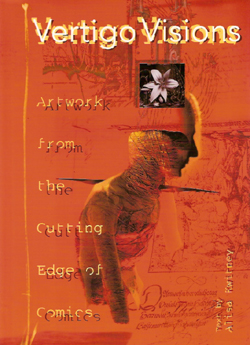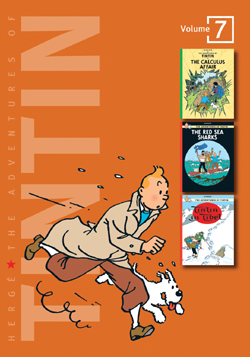
By Hergé, translated by Leslie Lonsdale-Cooper & Michael Turner (Egmont UK)
ISBN 13: 978-1-4052-2900-5
Hergé’s later life was troubled but his personal problems only seemed to enhance his storytelling abilities. The three tales collected in this volume of The Adventures of Tintin are sleek, polished comedy thrillers, rife with intrigue and camaraderie, and even after decades of working, continue fresh and challenging, as the author always sought new arenas of drama to explore.
The Calculus Affair once again sees the zany Professor abducted from the palatial home of Captain Haddock, resulting in a dire and desperate chase through Cold War Europe. Our heroes are hampered in their efforts to save their friend by the introduction of the infinitely annoying Insurance salesman Jolyon Wagg and more seriously, by two rival bands of spies.
As they pursue Calculus to Geneva, Tintin and Haddock encounter not only the insidious agents of Borduria but find that their erstwhile allies of Syldavia are also trying to make the Professor “disappearâ€. After frantic chases, pitched battles and assassination attempts diplomatic duplicity defeats them, and Calculus becomes an unwilling guest of the totalitarian Bordurians, who are pleased to accept as a “gift†his new invention, which they intend to use as a weapon of mass destruction.
Temporarily stymied, Tintin and Haddock finagle their way into the country, and with the aid of Opera Diva Bianca Castafiore, bamboozle the secret police to rescue the Professor and save the day.
Although all the elements in play are tried and trusted ingredients of the Tintin formula, the level of artistic achievement here is superb and the interplay of tense drama, slapstick comedy and breakneck action make this brooding thriller the most accomplished of Hergé’s tales. The simple fact that the contemporary Cold War fever is absent for modern readers makes no difference at all to the enjoyment of this magnificent graphic masterpiece.
The Red Sea Sharks has also lost some of its original contemporary urgency, but again that has had no diminishing effect. Produced during the turbulent times that led to the Middle-East Suez Crisis, it reintroduces Emir Ben Kalish Ezab from Land of Black Gold (see Adventures of Tintin volume 6 ISBN 13: 978-1-4052-2899-2) whose oil-rich country is in the throes of a civil war. Fearful of the consequences, he sends his son Abdullah to stay with Captain Haddock, unaware that the old dipsomaniac and Tintin are embroiled in another mystery involving General Alcazar (The Broken Ear: Adventures of Tintin volume 3, ISBN 13: 978-1-4052-2896-1), war surplus aircraft and a mysterious criminal mastermind.
As eager to escape the infernal practical jokes of the incorrigible Prince as to solve the case, the heroic pair follow the trail of the arms dealers and find themselves back in the Desert Kingdom of Khemed, albeit as unwelcome intruders as the rebels have defeated the Emir and driven him into hiding thanks to their illicitly gained fighter planes. When a bomb-plot leaves their plane crashed in the wastelands the indomitable pair trek overland into enemy territory before finally finding the Emir-in-hiding.
They discover that the coup has been instigated by the airline owned by the Marquis di Gorgonzola, a mysterious millionaire whose vast commercial interests are supplemented by selling Pilgrims en route to Mecca into slavery! Hot on the trail, the pair take ship for that holy city but are strafed by warplanes. Shooting one down they rescue the pilot, but when the trio are rescued by Gorgonzola’s yacht, Tintin discovers that one of his oldest foes is behind it all!
This spectacular high-adventure, despite its political and moral underpinnings, is primarily an action yarn with plenty of twists and turns and a terrific feel-good climax. This romp as well as standing proudly on its own lights serves as a subtle counterpoint for the last, and controversially different final tale of this volume…
Tintin in Tibet is not like any other story of the plucky, valiant boy reporter. At this time Hergé was ending a twenty-five year marriage, recovering from a series of nervous breakdowns and plagued by dreams of unending white. Rather than take a break or even retire he began the most eerie, mystical and personal story of his long career.
Tintin is holidaying in the mountains when he reads of a plane crash in Nepal. Inexplicably he screams the name of his old friend Chang, left behind in China at the end of The Blue Lotus (Adventures of Tintin volume 2 ISBN 13: 978-1-4052-2895-4). Now preoccupied with his old friend he discovers that Chang was on the crashed airliner and is believed dead. Despite all rational argument Tintin knows he has survived and immediately sets out to rescue him, with a protesting Captain Haddock in tow.
Against all odds the duo travels through India to the mountainous borderlands and into the Himalayas. Nothing can shake the boy’s obsessive belief that Chang is alive and urgently needs his help.
How the physical and mental hardships are overcome make for an uncharacteristically bleak tale, and the mysticism, paranoia and overt supernatural content is hard to fit comfortably into the fantastic but rational universe that Tintin inhabits. Yet it does work, and no other story so well depicts the heroic qualities of the lad and the deep emotional bond between him and his true friends, Chang and Haddock. Of course, Hergé’s utter professionalism would not allow him to produce anything that was not eminently readable, captivatingly funny and stirringly thrilling. Although perhaps the oddest tale this might just be the author’s most revealing.
The Calculus Affair: artwork © 1956, 1984 Editions Casterman, Paris & Tournai.
Text © 1960 Egmont UK Limited. All Rights Reserved.
The Red Sea Sharks: artwork © 1958, 1986 Editions Casterman, Paris & Tournai.
Text © 1960 Egmont UK Limited. All Rights Reserved.
Tintin in Tibet: artwork © 1960, 1984 Editions Casterman, Paris & Tournai.
Text © 1962 Egmont UK Limited. All Rights Reserved.
